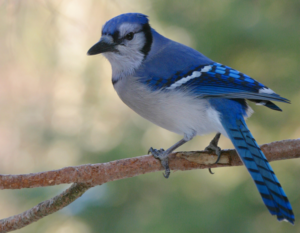Early returns from NH Audubon’s annual Backyard Winter Bird Survey point to fewer birds at feeders this winter. Why? It turns out the answer is not that simple. According to Dr. Pamela Hunt of NH Audubon, “there are many factors that influence the number of birds a person might see at their feeders during the winter, and most of them are not indicative of long-term population trends.”
In winter, birds form feeding flocks and wander around in search of food. If food is plentiful they may not need to visit feeders except perhaps in bad weather. If food is scarce, many birds might leave entirely. Food means natural food crops (not feeders) called mast – the seeds from trees, weeds, and fruit. Take Blue Jays, for example. They depend on acorns for food and in the fall of 2022, they left the state because of a poor acorn crop. Other winter visitors, such as the familiar Dark-eyed Junco (or “snowbird”), migrate a variable distance depending on food availability. If food is scarce in the north, more will continue south to the mid-Atlantic, but they’ll stay put if there’s plenty to eat in northern New England.

Then there are the birds called “winter finches,” including Evening Grosbeak and Common Redpoll. In most years these birds are quite rare, but then they can invade in huge numbers the following winter when their normal foods are hard to find in Canada. Even the familiar American Goldfinch shows this pattern, although they are still present each winter.
Concerns about bird declines were brought to light in a recent study that documented the loss of almost three billion birds in North America since 1970. The Granite State’s bird declines were summarized by Dr. Hunt in NH Audubon’s State of New Hampshire’s Birds report. According to Dr. Hunt, “Many birds here are declining: perhaps a third of our breeding species. However, a third are increasing as well, although the magnitudes of the increases are generally much lower than the magnitudes of the declines. Bottom line: there’s likely to have been a net loss of birds in New Hampshire over the last 50 years.”
The new strain of “highly pathogenic avian influenza” (HPAI, or avian flu) is too recent to be a cause of these long-term declines. Most mortality so far has been found in water birds that congregate in large flocks (increasing disease transmission) or scavengers that feed upon their carcasses. Smaller species can still be infected, just less commonly (although their carcasses are a lot harder to find). Disease can still cause of population declines in songbirds so it’s something to watch.
Yes, birds are declining, and there is cause for concern but many of our common winter birds, including cardinals, titmice, nuthatches, and woodpeckers, are showing long-term increases. This probably means that if you’re seeing fewer of them they’re most likely somewhere else.
What happened this winter was probably a combination of low snow cover creating good feeding in the woods, a poor mast crop resulting in the departure of some birds like Blue Jays and Red-breasted Nuthatches, and good food supplies up north keeping winter visitors in the north.
You can contribute to our knowledge of wintering bird populations by taking part in the NH Audubon’s annual Backyard Winter Bird Survey. Check the Results page for Dr. Hunt’s full article “Where are the Birds?”
